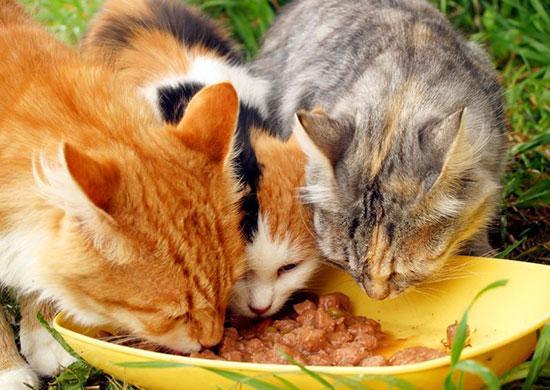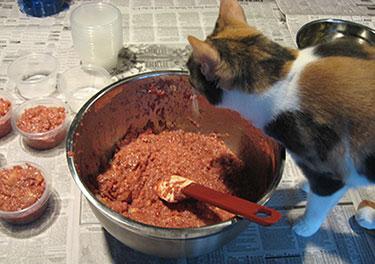This content is archived from the Feline Nutrition Foundation
Vitamin E: Liquid vs. Powder
- Updated: Thursday, May 23, 2019 05:23 PM
- Published: Saturday, May 26, 2012 12:34 PM
- Written by Marta Kaspar
 I feed my kitties ground raw cat food and add supplements. From what I have researched, liquid vitamin E is more easily assimilated into the body than the dry form. I was wondering why you suggest it in dry form in"Feline Nutrition's Easy Homemade Cat Food Recipe?"
I feed my kitties ground raw cat food and add supplements. From what I have researched, liquid vitamin E is more easily assimilated into the body than the dry form. I was wondering why you suggest it in dry form in"Feline Nutrition's Easy Homemade Cat Food Recipe?"
First, some background. While the term vitamin E sounds pretty straightforward, it is actually a quite complicated and often confusing subject. First of all, it is important to realize that it is not one single substance, but a group of fat soluble compounds known as the tocopherols. This includes alpha-, beta-, gamma- and delta-tocopherols and tocotrienols. In addition, it is not alone, as it has two relatives called vitamin E acetate and vitamin E succinate.
Most vitamin E compounds in their raw state are oils, except vitamin E succinate which is a powder. All types need to be diluted to much lower concentrations before they are sold to general public. The most common concentrations are 400IU, 200IU or 100IU per capsule or softgel. The inert substance used for dilution is called the carrier. It can be either a powder when the final product is sold dry in capsules, or an oil when the final product is a liquid in softgels. Since it is unlikely that the carrier would significantly influence absorption, it makes no difference whether you chose a liquid or powder.
What has been shown to make a difference in absorption is whether or not it is taken with fat-containing food. When taken by itself on an empty stomach or with water only, it is not absorbed well.¹ Most forms require some fat to be present to be absorbed properly.² Vitamin E supplements added to raw cat food would not have this problem, as adequate amounts of fat are present for optimum absorption.
Synthetic or Natural?
 Vitamin E is available in both natural and synthetic forms. It is easy to distinguish between the two. Fully synthetic vitamins have the prefix "dl-" in their names, while all-natural products have the "d-" prefix. For example, "d-alpha-tocopherol" would be a natural form of vitamin E and "dl-tocopheryl acetate" would be a synthetic product.
Vitamin E is available in both natural and synthetic forms. It is easy to distinguish between the two. Fully synthetic vitamins have the prefix "dl-" in their names, while all-natural products have the "d-" prefix. For example, "d-alpha-tocopherol" would be a natural form of vitamin E and "dl-tocopheryl acetate" would be a synthetic product.
What is IU?
Vitamin E content is listed on labels in international units. An international unit, abbreviated IU, is a unit of measurement for an amount of a substance based on its biological activity. Every type of vitamin E has a different biological activity. For that reason, different conversion factors need to be used when translating between milligrams and IUs, even between synthetic or natural types of the same compound.
How Much is Too Much?
Vitamin E has no known acute toxicity in cats.³ However, according to studies done in humans, it may be harmful if used in excess over a long period.⁴ According to AAFCO, NRC or CVMA guidelines, the allowance for an adult cat is from 1 to 3 IU per day.⁵
Additional Reading
Where Does Natural Vitamin E Come From?
Most natural forms are derived from vegetable oils, mostly soybean oil. By vegetable oils I mean cold-pressed oils, not the ones we buy in a supermarket. Most of those don't have much vitamin E left after their refinement and purification.
Note: Feline Nutrition provides feline health and nutrition information as a public service. Diagnosis and treatment of specific conditions should always be in consultation with your own veterinarian. Feline Nutrition disclaims all warranties and liability related to the veterinary advice and information provided on this site.
Marta Kaspar holds a master's degree in chemistry from the University of Pardubice in the Czech Republic. She is a research scientist, and a formulation and analytical chemist in both industrial and academic fields. Marta became interested in feline nutrition when her cats developed health problems. When she decided to prepare their food herself, the effect of the homemade raw meat diet on her cats was so impressive that she created the line of Alnutrin® supplements to help others transition their cats to better diets. You can find her atknowwhatyoufeed.com.
1. Yvonne M. Jeanes, Wendy L. Hall, Susan Ellard, Elizabeth Lee and John K. Lodge, "The Absorption of Vitamin E is Influenced by the Amount of Fat in a Meal and the Food Matrix," British Journal of Nutrition, no. 92, 2004, 575-579.
2. Yvonne M. Jeanes and others, "The Absorption of Vitamin E is Influenced by the Amount of Fat in a Meal and the Food Matrix."
3. US National Research Council Ad Hoc Committee on Dog and Cat Nutrition, Nutrient Requirements of Dogs and Cats, National Academies Press, 2006, 209-210.
4. Eva Lonn, MD, et. al., "Effects of Long-term Vitamin E Supplementation on Cardiovascular Events and Cancer," Journal of the American Medical Association 293, no. 11, 2005, 1138-1347.
5. Nutrient Allowances for Adult Maintenance per 100 kcal ME (metabolizable energy), compiled by the author from: AAFCO, Association of American Feed Control Officials, 1999 publication; NRC, National Research Council 2006 publication; and CVMA, Canadian Veterinary Medical Association 1993 publication. The recommendations from AAFCO, NRC and CVMA are between 0.75 IU to 2 IU per 100 kcal ME, and an average cat consumes anywhere from 120 to 160 kcal ME/day, depending on its size and other factors.




